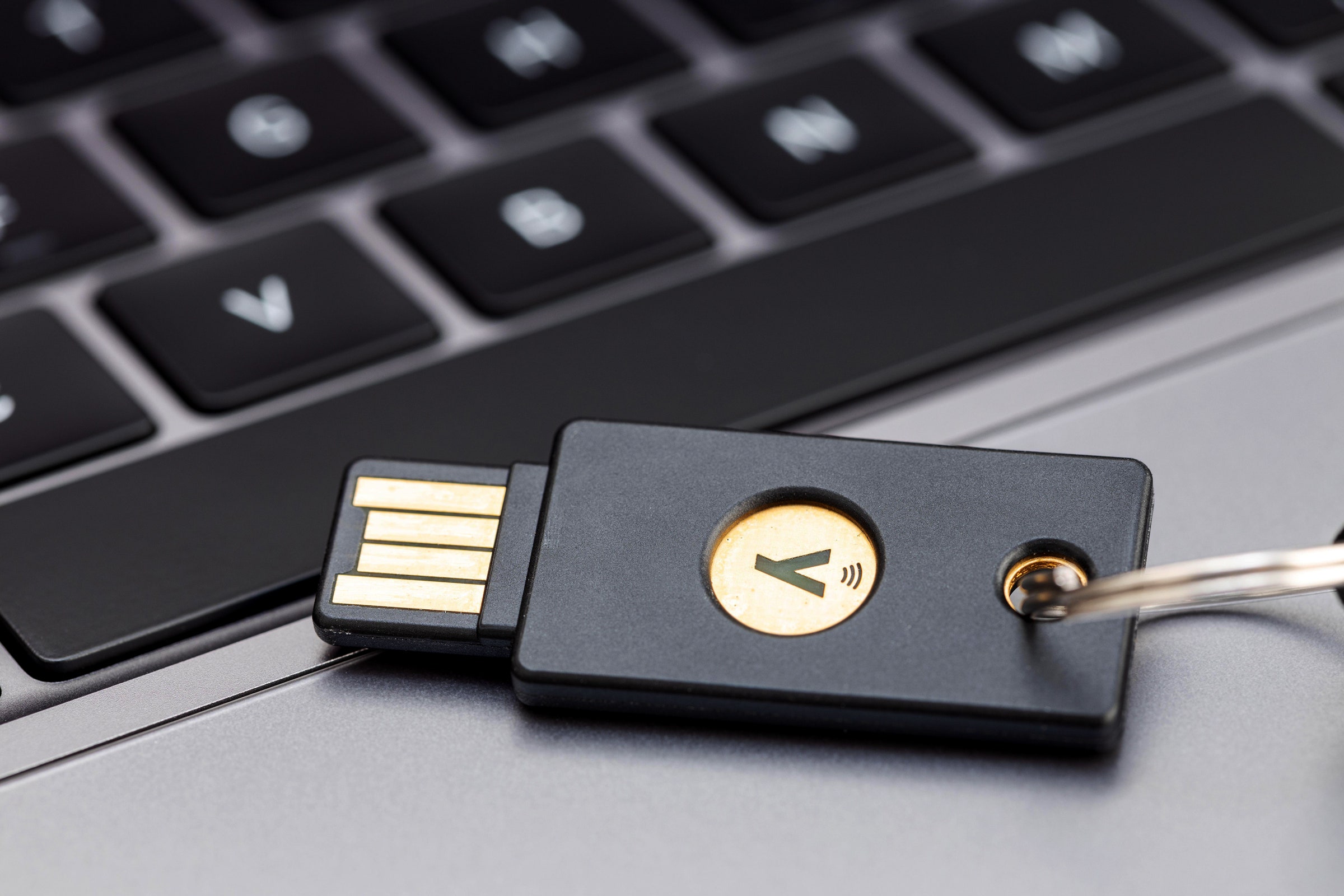YubiKeys Are a Security Gold Standard—but They Can Be Cloned

The YubiKey 5, the most widely used hardware token for two-factor authentication based on the FIDO standard, contains a cryptographic flaw that makes the finger-sized device vulnerable to cloning when an attacker gains temporary physical access to it, researchers said Tuesday.
The cryptographic flaw, known as a side channel, resides in a small microcontroller used in a large number of other authentication devices, including smartcards used in banking, electronic passports, and the accessing of secure areas. While the researchers have confirmed all YubiKey 5 series models can be cloned, they haven’t tested other devices using the microcontroller, such as the SLE78 made by Infineon and successor microcontrollers known as the Infineon Optiga Trust M and the Infineon Optiga TPM. The researchers suspect that any device using any of these three microcontrollers and the Infineon cryptographic library contains the same vulnerability.
Patching Not Possible
YubiKey maker Yubico issued an advisory in coordination with a detailed disclosure report from NinjaLab, the security firm that reverse engineered the YubiKey 5 series and devised the cloning attack. All YubiKeys running firmware prior to version 5.7—which was released in May and replaces the Infineon cryptolibrary with a custom one—are vulnerable. Updating key firmware on the YubiKey isn’t possible. That leaves all affected YubiKeys permanently vulnerable.
“An attacker could exploit this issue as part of a sophisticated and targeted attack to recover affected private keys,” the advisory confirmed. “The attacker would need physical possession of the YubiKey, Security Key, or YubiHSM; knowledge of the accounts they want to target; and specialized equipment to perform the necessary attack. Depending on the use case, the attacker may also require additional knowledge, including username, PIN, account password, or authentication key.”
Side channels are the result of clues left in physical manifestations such as electromagnetic emanations, data caches, or the time required to complete a task that leaks cryptographic secrets. In this case, the side channel is the amount of time taken during a mathematical calculation known as a modular inversion. The Infineon cryptolibrary failed to implement a common side-channel defense known as constant time as it performs modular inversion operations involving the Elliptic Curve Digital Signature Algorithm. Constant time ensures the time-sensitive cryptographic operations execute is uniform rather than variable depending on the specific keys.
More precisely, the side channel is located in the Infineon implementation of the Extended Euclidean Algorithm, a method for, among other things, computing the modular inverse. By using an oscilloscope to measure the electromagnetic radiation while the token is authenticating itself, the researchers can detect tiny execution time differences that reveal a token’s ephemeral ECDSA key, also known as a nonce. Further analysis allows the researchers to extract the secret ECDSA key that underpins the entire security of the token.
In Tuesday’s report, NinjaLab cofounder Thomas Roche wrote:
In the present work, NinjaLab unveils a new side-channel vulnerability in the ECDSA implementation of Infineon 9 on any security microcontroller family of the manufacturer. This vulnerability lies in the ECDSA ephemeral key (or nonce) modular inversion, and, more precisely, in the Infineon implementation of the Extended Euclidean Algorithm (EEA for short). To our knowledge, this is the first time an implementation of the EEA is shown to be vulnerable to side-channel analysis (contrarily to the EEA binary version). The exploitation of this vulnerability is demonstrated through realistic experiments and we show that an adversary only needs to have access to the device for a few minutes. The offline phase took us about 24 hours; with more engineering work in the attack development, it would take less than one hour.
After a long phase of understanding Infineon implementation through side-channel analysis on a Feitian 10 open JavaCard smartcard, the attack is tested on a YubiKey 5Ci, a FIDO hardware token from Yubico. All YubiKey 5 Series (before the firmware update 5.7 11 of May 6th, 2024) are affected by the attack. In fact all products relying on the ECDSA of Infineon cryptographic library running on an Infineon security microcontroller are affected by the attack. We estimate that the vulnerability exists for more than 14 years in Infineon top secure chips. These chips and the vulnerable part of the cryptographic library went through about 80 CC certification evaluations of level AVA VAN 4 (for TPMs) or AVA VAN 5 (for the others) from 2010 to 2024 (and a bit less than 30 certificate maintenances).
In an online interview, Roche elaborated:
Infineon produces “security microcontrollers” or “secure elements.” You can find many of them out there. Some of them (and this is the case for YubiKey 5 Series) run the Infineon cryptographic library (that Infineon develops for their customers that do not want to develop their own).
This cryptolibrary is highly confidential (even its API is secret, you need to sign an NDA with Infineon just to know the API). Nobody, but Infineon, knows the cryptolibrary details and notably its countermeasures choices.
This cryptolibrary, as many others, implement the ECDSA (core crypto function of FIDO, but also used in many different applications/protocols). Inside the ECDSA scheme, there are several sub-functions calls, one of them is the modular inversion of the ECDSA ephemeral key. This is a very sensitive operation: any information leaking about the ECDSA ephemeral key would eventually reveal the ECDSA secret key.
In the Infineon cryptolibrary the modular inversion is not constant time: different ephemeral key will lead to different inversion execution time. When acquiring the electromagnetic radiation of a chip running this function one can extract tiny differences of execution times throughout the inversion computation. These small timing leakages allow us to extract the ephemeral key and then the secret key.
The attacks require about $11,000 worth of equipment and a sophisticated understanding of electrical and cryptographic engineering. The difficulty of the attack means it would likely be carried out only by nation-states or other entities with comparable resources, and then only in highly targeted scenarios. The likelihood of such an attack being used widely in the wild is extremely low. Roche said that two-factor-authentication and one-time password functionalities aren’t affected: because they don’t use the vulnerable part of the library.
Tuesday’s report from NinjaLab outlines the full flow of the cloning attack as:
- The adversary steals the login and password of a victim’s application account protected with FIDO (e.g., via a phishing attack).
- The adversary gets physical access to the victim’s device during a limited time frame without the victim noticing.
- Thanks to the stolen victim’s login and password (for a given application account), the adversary sends the authentication request to the device as many times as is necessary while performing side-channel measurements.
- The adversary quietly gives back the FIDO device to the victim.
- The adversary performs a side-channel attack over the measurements and succeeds in extracting the ECDSA private key linked to the victim’s application account.
- The adversary can sign in to the victim’s application account without the FIDO device and without the victim noticing. In other words, the adversary created a clone of the FIDO device for the victim’s application account. This clone will give access to the application account as long as the legitimate user does not revoke its authentication credentials.
The list, however, omits a key step, which is tearing down the YubiKey and exposing the logic board housed inside. This likely would be done by using a hot air gun and a scalpel to remove the plastic key casing and expose the part of the logic board that acts as a secure element storing the cryptographic secrets. From there, the attacker would connect the chip to hardware and software that take measurements as the key is being used to authenticate an existing account. Once the measurement-taking is finished, the attacker would seal the chip in a new casing and return it to the victim.
Left: a YubiKey 5Ci intact; Right: the logic board found inside.
Courtesy of NinjaLab
Two images showing how the electromagnetic radiation is measured using a probe.
Courtesy of NinjaLab
The attack and underlying vulnerability that makes it possible are almost entirely the same as that allowed NinjaLab to clone Google Titan keys in 2021. That attack required physical access to the token for about 10 hours.
The attacks violate a fundamental guarantee of FIDO-compliant keys, which is that the secret cryptographic material they store can’t be read or copied by any other device. This assurance is crucial because FIDO keys are used in various security-critical environments, such as those in the military and corporate networks.
That said, FIDO-compliant authentication is among the most robust forms of authentication, one that’s not susceptible to credential phishing or adversary-in-the-middle attacks. As long as the key stays out of the hands of a highly skilled and well-equipped attacker, it remains among the strongest forms of authentication. It’s also worth noting that cloning the token is only one of two major steps required to gain unauthorized access to an account or device. An attacker also must obtain the user password used for the first factor of authentication. These requirements mean that physical keys remain among the most secure authentication methods.
To uncover the side channel, the researchers reverse engineered the Infineon cryptographic library, a heavily fortified collection of code that the manufacturer takes great pains to keep confidential. The detailed description of the library is likely to be of intense interest to cryptography researchers analyzing how it works in other security devices.
People who want to know what firmware version their YubiKey runs can use the Yubico Authenticator app. The upper-left corner of the home screen displays the series and model of the key. In the example below, from Tuesday’s advisory, the YubiKey is a YubiKey 5C NFC version 5.7.0.
YubiKeys provide optional user authentication protections, including the requirement for a user-supplied PIN code or a fingerprint or face scan. For the cloning attack to work against YubiKeys using these additional measures, an attacker would need to possess the user verification factor as well. More information about using these additional measures to lock down YubiKeys further is available here.
A key question that remains unanswered at the moment is what other security devices rely on the three vulnerable Infineon secure modules and use the Infineon cryptolibrary? Infineon has yet to issue an advisory and didn’t respond to an email asking for one. At the moment, there is no known CVE for tracking the vulnerability.
This story originally appeared on Ars Technica.




